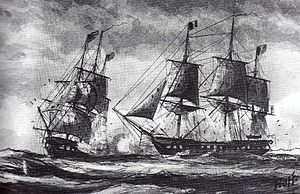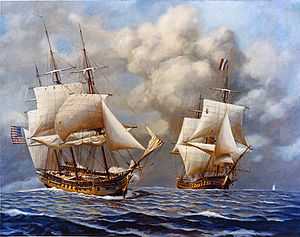USS Insurgent
 Naval encounter during the Quasi-War between USS Constellation and French ship Insurgente (right) on 9 February 1799. | |
| Career (France) | |
|---|---|
| Name: | Insurgente |
| Ordered: | 3 September 1790 |
| Builder: | Pierre-Joseph Pénétreau, Lorient |
| Laid down: | 5 November 1791 |
| Launched: | 27 April 1793 |
| Captured: | by USS Constellation, 9 February 1799 |
| Career (United States) | |
| Name: | USS Insurgent |
| Acquired: | 9 February 1799 |
| Commissioned: | August 1799 |
| Fate: | Lost at sea, probably foundered September 1800 |
| General characteristics | |
| Type: | Sémillante class frigate |
| Tons burthen: | 600 tonnes |
| Length: | 45.5 metres |
| Beam: | 11.5 metres |
| Draft: | 5.5 metres |
| Complement: | French service:Officers + 278 men[1] US Service: 340 officers and enlisted |
| Armament: | French service (initially):
French service (1798-99):
US service:
|
Insurgente was a 40-gun Sémillante-class frigate of the French Navy, launched in 1791. USS Constellation, Captain Thomas Truxtun in command, captured her off the island of Nevis during the Quasi-War. After capture she served in the US Navy patrolling the waters in the West Indies. In September 1800 she was caught up in a severe storm and was presumed lost at sea.[2][3]
French frigate Insurgente
Insurgente was built by Pierre-Joseph Pénétreau at Lorient and launched on 27 April 1793.[1]
Battle with Constellation
On 9 February 1799, after being at sea for three days, the USS Constellation spotted Insurgente approximately six leagues northeast off Nevis. Insurgente, a fully rigged frigate, was considered one of the fastest sailing vessels in the world at the time; three weeks earlier she had encountered Constellation but was able to outrun her and escape.[4] Shortly after being spotted by Constellation this second time the ships encountered a squall during which a violent gust of wind snapped Insurgente 's topmast, impairing her speed. As Constellation approached, Captain Michael-Pierre Barreaut first attempted to seek haven by making for St. Eustatius, but to no avail, where Insurgente hauled wind and assumed a starboard tack. After being overtaken she hoisted American colors, at which time the Constellation hoisted the private signals. Unable to respond appropriately, she gave up her attempt at disguise and Captain Barreaut ordered the French tri-colors hoisted and a gun fired to windward to signal the challenge where Insurgente boldly sat in wait to be engaged. This was the first time since the American Revolution that a shot had been fired from an enemy vessel at an American ship. Truxtun gave the order to clear the deck of Constellation for action and the boatswain sounded the whistle. Both ships bore up to take positions to engage. The Constellation fired the first broadside, double-shotted, inflicting much damage to the French vessel's hull and killing many in the first minute of the engagement. Insurgente responded and fired a broadside, inflicting much damage to Constellation's rigging and top foremast, almost cut off.[5] At 3:30 PM after and hour and a half of running battle and several raking broadsides from the Constellation the Insurgente struck her colors. First Lieutenant John Rodgers, Midshipman David Porter along with eleven men were put on board the captured vessel to take possession and to secure the prisoners who were sent to the lower hold. She had lost 70 men from a crew of 409, while Constellation, badly damaged also, only lost three out of a complement of 309. This was the first American victory against a foreign naval vessel.[6][7]
There were no handcuffs to be found and the prisoners seem disposed to rebel. Accordingly Rodgers placed sentries at the hatch, armed with blunderbusses and under orders to open fire should the prisoners attempt to breach the hatch way.[8]

Service in US Navy
The US Navy considered Insurgent a prize in the Quasi-War with France. The frigate was taken to the West Indies and refitted for service in the young American navy. It cruised under Lt. John Rodgers in company with Constellation until May 1799. Ordered back to the United States, Insurgent was purchased by the Navy for $84,500. Commissioned with Captain Alexander Murray in command, Insurgent sailed from Hampton Roads for Europe on 14 August 1799. Cruising in European waters during the winter of 1799-1800, the frigate captured French ship Vendémiaire and recaptured the American ships Margaret, Angora, Commerce, and William and Mary. Insurgent returned to the United States in March 1800 via the West Indies.[9]
On 29 April 1800 Patrick Fletcher assumed command and was ordered to cruise between the West Indies and the American coast to protect American shipping interests see and to capture any enemy vessels he encountered. Insurgent departed Baltimore 22 July and after a brief stop at Hampton Roads sailed for her station 8 August 1800. Never heard from again, the frigate and her crew were presumed lost as a result of the severe storm which struck the West Indies 20 September 1800.[10]
See also
- List of French sail frigates
- Original six frigates of the United States Navy
- List of ships captured in the 18th century
- Glossary of nautical terms
Citations
- ↑ 1.0 1.1 1.2 1.3 1.4 Demerliac (1996), p.68, #421.
- ↑ U.S.Navy, DANFS, Insurgent prgh.1
- ↑ Toll, 2006 pp.142-144
- ↑ Toll, 2006 p.115-117
- ↑ Toll, 2006 p.117
- ↑ Harrison, 1858 p.156-158
- ↑ Toll, 2006 pp.117-119
- ↑ Harrison, 1858 p.158
- ↑ U.S.Navy, DANFS, Insurgent prgh.2
- ↑ U.S.Navy, DANFS, Insurgent prgh.3
References
- Demerliac, Alain (1996) La Marine De Louis XVI: Nomenclature Des Navires Français De 1774 À 1792. (Nice: Éditions OMEGA). ISBN 2-906381-23-3
- Harrison, Henry William (1858). Battlefields and naval exploits of the United States: ...
H. C. Peck & Theo. Bliss, Philadelphia. p. 448. - Dept U.S.Navy. "Ship's Directory". Dictionary of American Naval Fighting Ships.
DEPARTMENT OF THE NAVY -- NAVAL HISTORICAL CENTER. Retrieved 18 October 2011. - Toll, Ian W. (2006). Six frigates: the epic history of the founding of the U.S. Navy.
W. W. Norton & Company, New York. p. 592. ISBN 978-0-393-05847-5.